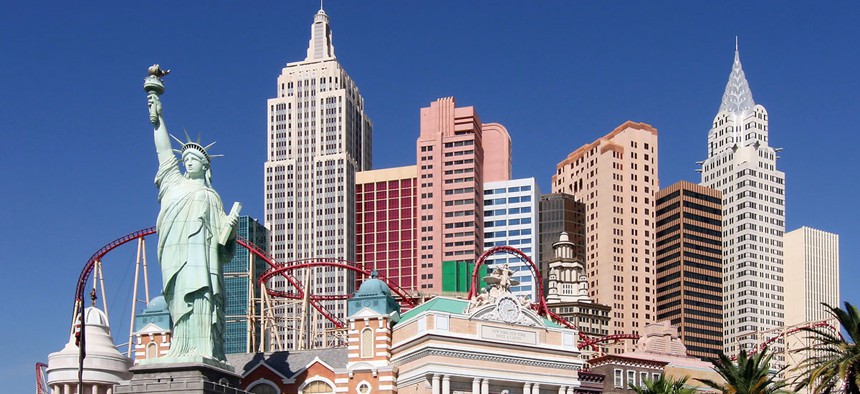
The new "New Colossus" in front of the New York Hotel and Casino in Las Vegas Matej Hudovernik / Shutterstock.com
The Postal Service Owes an Artist $3.5M for Putting the Wrong Statue of Liberty on a Stamp
The court ruling offers an important reminder that artistic originality manifests in many subtle ways—not just completely unique takes.
The Statue of Liberty is a beloved American symbol. That’s why, in 1996, the New York-New York Hotel and Casino in Las Vegas, Nevada, commissioned a replica of the iconic lady. Sculptor Robert Davidson gave the classic statue a fresh look, with softer facial features inspired by a photograph of his mother-in-law. And so when the US Postal Service featured the “mighty woman with a torch” on its 2011 Forever stamp, experts knew that the stamp depicted not the original statue, but Davidson’s creation.
Now a federal court has ruled that USPS must pay Davidson $3.5 million for its accidental copyright infringement. The June 29 ruling explains that the postal service mistakenly printed and sold stamps with the replica statue’s face on it, having failed to distinguish between the real Lady Liberty and her Las Vegas counterpart. The court ruling offers an important reminder that artistic originality manifests in many subtle ways—not just completely unique takes.
The agency chose the replica’s face to feature on its stamp because it was distinctive. It looked like no other image of the Statue of Liberty that the agency was considering for its “workhorse” stamp. “That was its appeal…There are only so many ways to continue to reinterpret an iconic image,” a USPS representative testified about his choice. In 2011, the postal service discovered the error. But it didn’t issue a clarification or contact the artist to credit him or pay for his contribution to what was turning out to be a popular and lucrative stamp.
Davidson in 2013 sued USPS for copyright infringement. The postal service argued that the artist had no copyright over an iconic symbol. But the sculptor countered that his was an original—not an exact copy of Lady Liberty but a unique, updated interpretation. Ultimately, the court sided with the artist, finding Davidson’s work was an original sculpture and therefore protected by copyright.
The artist testified at trial that he never intended to replicate Lady Liberty exactly. Just as the Vegas hotel’s imitation New York skyline wouldn’t be an exact replica of the city, neither would his statue be a precise take on the iconic American symbol.
Davidson testified at trial that he looked at a picture of his mother-in-law every day while creating the visage. “I just thought that this needed a little more modern, a little more contemporary face, definitely more feminine, just something that I thought was more appropriate for Las Vegas,” he explained. Indeed, his sculpture is dedicated to his mother-in-law, whom he called “mom.”
The court concluded that Davidson succeeded in his attempt to create an update. The opinion states:
A comparison of the two faces unmistakably shows that they are different…We agree that Mr. Davidson’s statue evokes a softer and more feminine appeal. The eyes are different, the jaw line is less massive and the whole face is more rounded.
The government sold the stamp in question in conjunction with a flag stamp, which together yielded $4 billion. The court notes that about $70 million of those proceeds amounted to profits on the Statue of Liberty stamp alone. It rejected USPS’s claims that it owed nothing for this use because the stamp hadn’t harmed Davidson’s sculpting business, writing, “That may be true, but we also note that it certainly did not benefit him. The Postal Service offered neither public attribution nor apology.”
Based on testimony from philatelists and art licensure experts, the court came up with the $3.5 million award for Davison’s injury. This amounts to 5% of the profits USPS made on the Statue of Liberty stamp based on the Vegas replica. The figure represents royalties Davidson would have made if he could have negotiated a license with USPS, and ignores the government’s testimony that it rarely pays more than $5,000 for a license to use artwork in its stamps.
It’s certainly a substantial sum, considering the original sculpture in New York Harbor symbolizes the humble, immigrant roots of so many Americans. In the 1883 sonnet written to raise funds for Lady Liberty’s construction, The New Colossus, Emma Lazarus wrote of, “A mighty woman with a torch, whose flame, Is the imprisoned lightning, and her name, Mother of Exiles.” This mother would welcome all and “with silent lips,” utter,”Give me your tired, your poor, Your huddled masses yearning to breathe free, The wretched refuse of your teeming shore.”
But of course, the Las Vegas update of Lady Liberty—created for a casino—has shaken those old-timey preoccupations. The new new colossus looks softer, but she’s a less substantial symbol—made of styrofoam and glass rather than iron and copper. And apparently, she’s worth millions.






